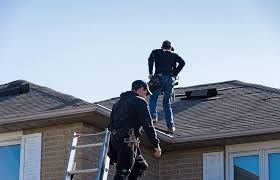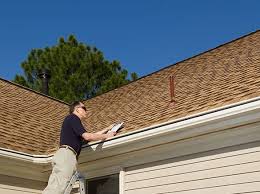A regular roof inspection can head off expensive repairs.
A roof inspection is one of those preventative maintenance jobs that’s easy to overlook. Don’t. Add a once-a-year reminder on your calendar to go out on a warm day and address any roof problems you find.
If you’re squeamish about heights, don’t worry. You can do a thorough inspection from the ground using a pair of binoculars.
Or, you can get up close and personal with your roof using a ladder. However, there’s no need to get up on your roof just yet. The less you walk around up there, the better for your roofing — and the safer for you. Work your way around your house, noting any potential problems.
Here’s a roofing inspection checklist:
- Cracked caulk or rust spots on flashing.
- Shingles that are buckling, curling, or blistering.
- Missing or broken shingles.
- Cracked and worn rubber boots around vent pipes.
- Missing or damaged chimney cap. (OK, that’s technically not part of your roof, but since you’re looking anyway.)
- Masses of moss and lichen, which could signal the roof is decaying underneath. Black algae stains are just cosmetic.
If you find piles of colored grit from asphalt roof tiles in the gutters, that’s a bad sign — those sand-like granules cover the surface of roof shingles and shield them from the sun’s damaging ultraviolet rays. Check the age of your roofing and see if it’s nearing the end of its life cycle.

When to Schedule an Inspection
For most homeowners, roof inspections should get scheduled at least twice a year—once in the spring and again before winter. This will let you catch minor roof damage before severe weather has a chance to cause leaks in your home.
That said, you should also schedule an inspection after severe storms and anytime you notice issues when walking around the exterior of your house. Remember, not all roof damage will be visible and severe weather has a way of hurting the integrity of your roof without necessarily making it look damaged.
Staying on top of your inspections will help you keep your roof in good condition.
When in doubt, schedule an inspection. Even if you’re fairly certain that your roof is okay, it’s always best to play it safe. The last thing you want is to discover that a loose shingle created a major leak that’s causing structural damage to your home.

Why Your Roof Should Be Inspected
Roof inspections simply determine the integrity of a roof, how long it may last, if it needs repairs and when it will need to be replaced. Roof inspectors have special procedures wherein they can determine the lifespan of a given roof without ripping it apart.
Roof inspections are important because they help prevent major problems from occurring. If roof inspections aren’t regularly performed, serious problems can develop, leading to leaks and damage to the interior of your home or business.
The National Roofing Contractors Association recommends checking your roof at least twice a year, in the fall and spring when the weather is milder to catch any problems. A roof should also be inspected after a major weather event.

What can you do to stay on top of roofing repairs?
Now that you know why it’s important not to put off the roofing repairs that you need, you need to know how to stay on top of them. Roofing issues aren’t always obvious to homeowners, and these tips will help you catch them early so that you can get the prompt repairs you need:
Keep an eye on your roof.
You don’t need to get on top of your roof to catch roofing problems before they get out of hand. Invest in a pair of binoculars and keep an eye on your roof to watch out for signs of damage from the ground. While this isn’t a perfect solution for catching all roofing issues, if you do it regularly enough, it can alert you to any changes in your roof that may be cause for concern, like missing shingles or finding shingle granules in your gutters.
Schedule regular roofing inspections.
The professionals can catch roofing issues that you may have missed in your own inspection, and it’s important to get professional roofing inspections done on a regular basis. Roofing inspections can help you to keep your warranty intact, catch small issues before they cause a lot of damage and get professional advice on how to care for your roof properly. You should schedule an inspection on your roof twice a year: once before winter and once after winter. This way, you can ensure that your roof is ready to take on the harsh weather that winter brings and that any damage caused during the winter can be corrected as soon as possible.
Don’t procrastinate when you need repairs.
The most important thing you can do to stay on top of your roof repairs is to avoid procrastinating when there is an issue with your roof. Waiting to get the roof repairs you need will only lead to an increase in damage and cost, and you won’t be doing yourself any favors by procrastinating.
Reasons a roofing inspection is more important than you think
We all know the importance of “preventive medicine” – those dreaded annual checkups and biannual dentist visits – but many of us don’t take any action until there’s a problem. It’s a gamble: Sometimes we win, saving time and money while escaping negative consequences. Other times, though, what would have been a small problem takes advantage of that time to develop into a big problem, costing much more in both time and money than if it had been nipped in the proverbial bud.
In other words, when those gambles fail, they fail big. Unfortunately, far too many building owners and facility managers take the same approach to getting a roof inspection. Why is that a bad idea? Read on to find out.
1. Catch Problems While They’re Small
Most of the time – major storms being the primary exception – roofing problems don’t happen overnight. They start with something seemingly innocuous, like leaning pipe supports, and progress to a puncture and leak. An inspection by someone who’s familiar with the early warning signs can correct things before they go too far.
By the time you see a leak, for example, you could already have structural damage to the roof, damage to equipment and inventory, or mold. In addition, it can take more time and effort to correct a problem once it’s progressed. A leak on a flat roof, for example, can travel laterally, disguising the location of the actual breach.
2. Protect your Warranty
Most roofing warranties require an annual or biannual roof inspection. If you can’t prove that you had these done by a qualified roofing professional, you may void your warranty. So check the fine print!
3. Make a Course Correction
Not only does a regular roof inspection help you catch problems while they’re still small, they also give you the chance to stop doing things that are inadvertently harming your roof. For example, if an inspector discovers excess wear on your rooftop, you can take preventive action by installing walkways in high-traffic areas and limiting access to other areas.
Establishing a sign-in and sign-out procedure can motivate employees to take extra care when they’re doing work on the roof. Or, if constant rooftop visits to repair an aging HVAC system are taking their toll, you have the chance to decide that a replacing your rooftop equipment would be more cost-effective than the inevitable roof repairs. And there’s always the chance that you’ll discover that a bad pipe supports design is causing problems, giving you time to make the necessary structural changes.
4. Avoid Losses from Secondary Damage and Downtime
As if replacing a roof wasn’t already expensive enough, related costs can add up fast. Damaged inventory can result in delays, lost sales, and unhappy customers. The same is true for damaged equipment. And damage to internal structures and flooring can result in downtime, which, depending on the extent of the damage, could be long enough to endanger the entire enterprise. Few businesses operate at such a high-profit margin that they can absorb a shutdown painlessly.
If you’re not convinced yet, think of it this way: Catching just one problem while it’s still small could more than make up for the time and expense of scheduling a regular inspection.